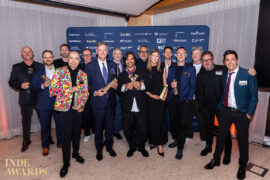New Bridge by Cox Rayner Architects paves the way for the future.
December 1st, 2008
The world’s first tensegrity pedestrian bridge, designed by Cox Rayner Architects, is due to be completed later this year on the banks of the Brisbane River.
The Kurilpa Bridge, commissioned as part of Premier Anna Bligh’s commitment to providing better access for pedestrians and cyclists, and has already been singled out for its innovative approach to design.
Taking the unique principle of tensegrity – which allows a structure to be concurrently strong, yet incredibly light – the bridge will link the city’s legal precinct to its cultural hub and provide a 425 metre pathway for users.
Baulderstone Kurilpa Bridge Project Manager Paul Stathis says that it was a combination of the engineers wanting the challenge of building something very lightweight and efficient and the architects wanting to build something that wasn’t just a ‘run-of-the-mill’ concrete bridge. “It’s not just unique in appearance, it’s unique in design and engineering,’’ Stathis says.
He says that while each of the 12.8m bridge deck segments are uniform, the cables that support the bridge differ in length, angle and load, creating engineering challenges.
“We are building the bridge deck piece by piece, night by night. Every element that’s installed is random, with the exception of the deck and the crossbeams – but the work is definitely not speculative or random,” Stathis says.
Check out the project progress here
INDESIGN is on instagram
Follow @indesignlive
A searchable and comprehensive guide for specifying leading products and their suppliers
Keep up to date with the latest and greatest from our industry BFF's!

CDK Stone’s Natasha Stengos takes us through its Alexandria Selection Centre, where stone choice becomes a sensory experience – from curated spaces, crafted details and a colour-organised selection floor.

For those who appreciate form as much as function, Gaggenau’s latest induction innovation delivers sculpted precision and effortless flexibility, disappearing seamlessly into the surface when not in use.

For a closer look behind the creative process, watch this video interview with Sebastian Nash, where he explores the making of King Living’s textile range – from fibre choices to design intent.

London-based design duo Raw Edges have joined forces with Established & Sons and Tongue & Groove to introduce Wall to Wall – a hand-stained, “living collection” that transforms parquet flooring into a canvas of colour, pattern, and possibility.
Henry Wilson has taken out this year’s Bombay Sapphire Design Discovery Award for his A-Joint joinery system.

Tania Spława-Neyman is a sessional lecturer at the School of Fashion & Textiles and a PhD candidate at the School of Architecture & Design, RMIT University
The internet never sleeps! Here's the stuff you might have missed

With the opening of the 2026 INDE.Awards program, now is the time to assess your projects, ensure photography is at hand and begin your submissions.

BLP’s new Sydney Children’s Hospital, Randwick building brings together paediatric care, family-centred design and Australia’s first Children’s Comprehensive Cancer Centre in a major addition to the Randwick Health & Innovation Precinct.